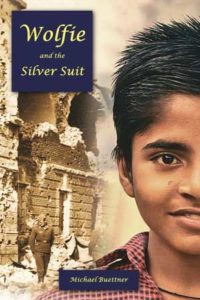Wolfie and the Silver Suit
Reviewed by Hina Fathima
December 1, 2017
 By Michael Buettner. Self-published, 2016. 155 pages. $4.99/eBook. Recommended for ages 10–12.
By Michael Buettner. Self-published, 2016. 155 pages. $4.99/eBook. Recommended for ages 10–12.
I sat down to write this after visiting a Rohingya refugee camp in New Delhi. Back at my computer, I began to process photos and browse through the footage of the Rohingya children. Some were as old as Wolfie, the protagonist of this book. They looked like the child on the cover of Wolfie and the Silver Suit, only more impoverished, dusty, and disheveled.
Wolf Hebert is a German boy whose parents leave him behind at a refugee camp while they mysteriously return to the turmoil of German society at the end of World War II. Wolfie’s father has invented a “silver suit” to help civilians escape bombings and firestorms. The invention was created a bit too late as the war was nearing an end, but German soldiers used the suit to rescue civilians from bombings, bullets, and fires. Wolfie receives a suit of his own, which he uses to help others during the war and to overcome his haunting fears.
The book touches upon the dark aspects of war: violence, resistance, concentration camps, poverty, displacement, survival, hunger, and trauma. While the overall book is engaging, the plot felt loose at times, such as the portrayal of Wolfie’s relationship with his parents. While Wolfie’s search for his parents and his friendship with the Romani boy Yoska forms the backbone of the book, the conclusion of the events is very abrupt and unsatisfying.
Despite the weakness in plot, the strength of Wolfie and the Silver Suit lies in the interweaving of its more human themes of friendship, courage, and trauma. The friendship between Wolfie and Yoska is what carries this book—how two boys from completely different ethnic, social, and class backgrounds are able to bond over the loss and trauma caused by war. The characterization of Yoska debunks common tropes about Gypsies: that they are uncivilized, thieves, “others.” At times, Yoska’s character feels stronger and more interesting than Wolfie’s, yet he remains the foil to our protagonist. I found this troubling because it is a common pattern in books, movies, and television dramas in the West where a person of color, no matter how compelling a character, often remains a sidekick to the white protagonist. The doctor’s character is also interesting as it shows the involvement of American Quaker relief efforts during the war.
Considering that the book is written for young readers, Buettner does an admirable job of sensitizing readers to war trauma. One way he navigates it is through Yoska’s and Wolfie’s friendship—how loss can be healed through new bonds of human connection—and the other is through art. Both Wolfie and Yoska confront their personal fears and come to terms with loss through paintings and sketches depicting their experiences. The doctor also notes that art is a good way to document the scars left behind by war.
Wolfie and the Silver Suit could be an essential read in classrooms especially given the war and strife-torn times that we are living in today. This book will not only familiarize students with the history of World War II and the Holocaust but also sensitize them to the conflicts and ethnic and religious persecution happening around the world today. There were so many Wolfies and Yoskas that I saw in the faces of the Rohingya children, and the world needs to read about them and become more aware of our role and responsibility in these man-made crises.



Comments on Friendsjournal.org may be used in the Forum of the print magazine and may be edited for length and clarity.